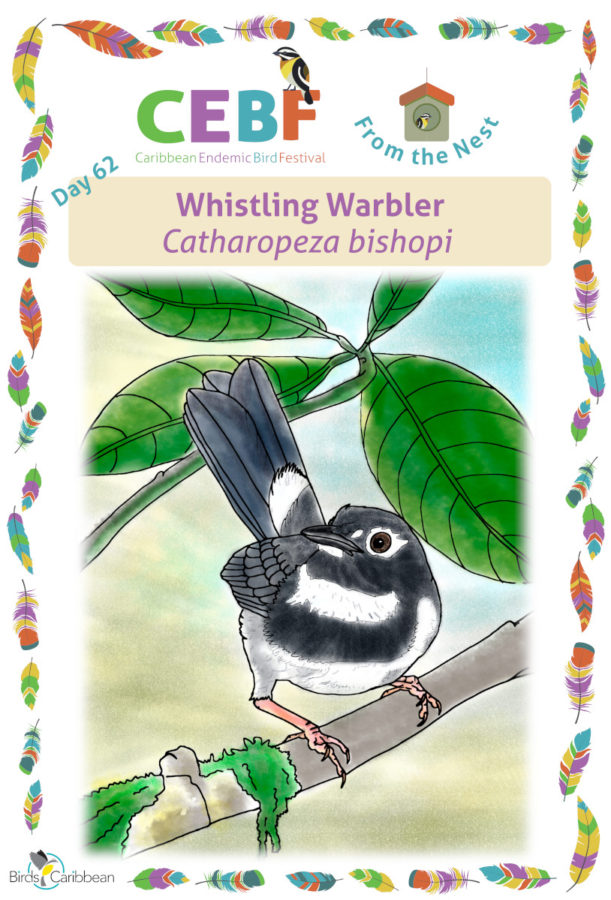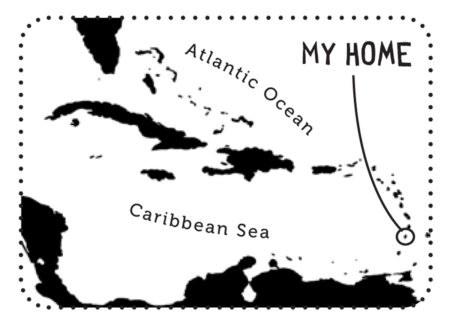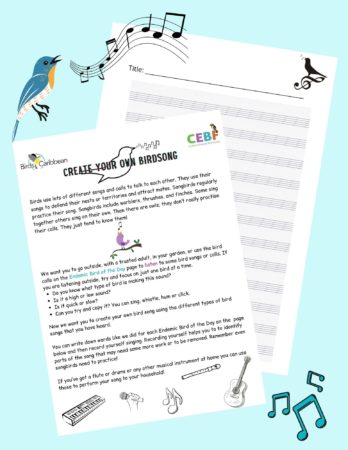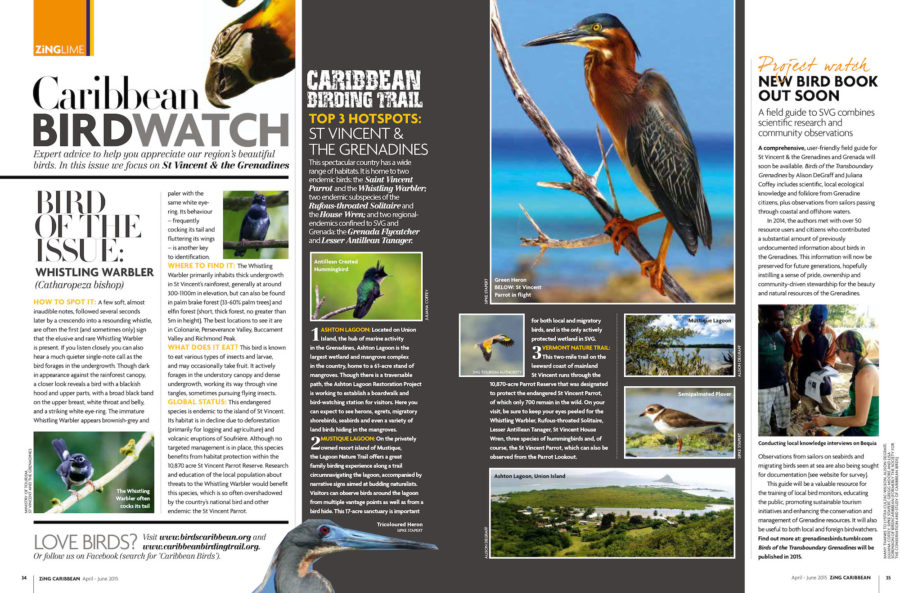Celebrate the Caribbean Endemic Bird Festival (CEBF) with us! Our theme in 2021 is “Sing, Fly, Soar—Like a Bird!” Have fun learning about a new endemic bird every day. We have colouring pages, puzzles, activities, and more. Download for free and enjoy nature with your family at home.
Endemic Bird of the Day: Whistling Warbler
A few soft, almost inaudible notes, followed several seconds later by a crescendo into a resounding whistle, are often the first (and sometimes only) sign that the elusive and rare Whistling Warbler is present. If you listen closely, you can also hear a much quieter single-noted call as the bird forages in the undergrowth. Though dark in appearance against the rainforest canopy, a closer look reveals a bird with a blackish hood and upperparts, with a broad black band on the upper breast, white throat and belly, and a striking white eye-ring. The immature Whistling Warbler appears brownish-grey and paler with the same white eye-ring. Its behavior – frequently cocking its tail and fluttering its wings – is another key to identification.
The Whistling Warbler lives in the thick undergrowth in St. Vincent’s rainforest, generally from 300-1,100m in elevation. They can also be found in palm brake forest (33-60% palm trees) and elfin forest (short, thick forest, no greater than 5m in height). The best locations to see them are in Colonarie, Perseverance Valley, Buccament Valley, and Richmond Peak.
Whistling Warblers are known to eat various types of insects and larvae, though they may occasionally take fruit as well. They actively forage in the understory canopy and dense undergrowth, working their way through vine tangles, sometimes pursuing flying insects.
The Whistling Warbler is endemic to the island of Saint Vincent in the Lesser Antilles and its status is Endangered. Its habitat is in decline due to deforestation (primarily for logging and agriculture) and volcanic eruptions of Soufrière. On April 9th, 2021 La Soufrière volcano began erupting – continued eruptions have caused extensive damage to its habitat. Although there is no targeted management in place, this species benefits from habitat protection within the 10,870 acre Saint Vincent Parrot Reserve. Research and education of the local population about threats to the Whistling Warbler would benefit this species, which is so often overshadowed by the country’s national bird and other endemic: the Saint Vincent Parrot. Learn more about this species, including its range, photos, and calls here.
Colour in the Whistling Warbler
Download our West Indies Endemic Bird colouring page. Use the photos below as your guide, or you can look up pictures of the bird online or in a bird field guide if you have one. Share your coloured-in page with us by posting it online and tagging us @BirdsCaribbean #CEBFfromthenest
Listen to the song of the Whistling Warbler
The song of the Whistling Warbler consists of an ascending trill of loudly whistled notes.
Puzzle of the Day
Click on the image below to do the puzzle. You can make the puzzle as easy or as hard as you like – for example, 6, 8, or 12 pieces for young children, all the way up to 1,024 pieces for those that are up for a challenge!
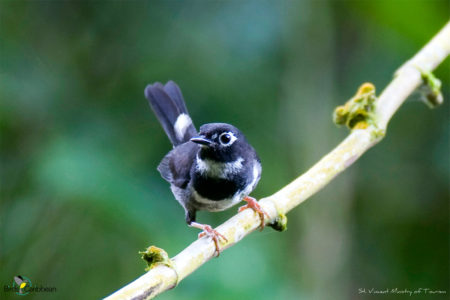
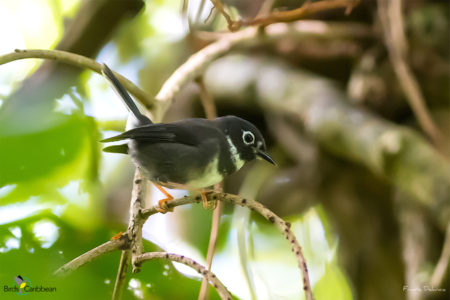
Activity of the Day
FOR KIDS: Get creative and try singing (or playing a musical instrument) like a bird! Be inspired by the Whistling Warbler, or one of our other featured endemic birds or get outside and listen out for the sounds the birds are making and create your own birdsong! You can download our instructions here to help you make some melodious bird-inspired tunes.
We would love to hear your birdsong! Send us a recording of your performance to Aliya.Hosein@birdscaribbean.
Please note that by submitting your video you give BirdsCaribbean consent to use your photos and/or videos on our website and social media accounts.
FOR KIDS AND ADULTS: Learn more about the birds of St. Vincent and the Grenadines, including the Whistling Warbler, and get tips on some top birding hotspots in this Caribbean BirdWatch article in ZiNG magazine, LIAT Airlines in-flight magazine.
Birds on St. Vincent Need your help
The recent eruptions of the La Soufrière Volcano threaten the iconic St. Vincent Parrot and the other amazing birds on St. Vincent. The normally lush green landscape of this beautiful country is now blanketed in gray ash. It’s possible that the eruptions, ash fall and damaging pyroclastic flows could go on for weeks; devastating an island already suffering from the health and economic impacts of the pandemic. Humanitarian efforts are well underway, but the wildlife also needs our help!
We are very concerned about the impacts to many regional and endemic birds on St. Vincent, particularly the threatened St. Vincent Parrot (Amazona guildingii), listed as Vulnerable, and the Whistling Warbler, listed as Endangered.
Other restricted-range endemic species (12) include the Grenada Flycatcher, Rufous-throated Solitaire, Purple-throated Carib, Brown Trembler, Lesser Antillean Tanager, Antillean Euphonia, and others.
Help is already on it’s way, with the first shipment of equipment having been sent! This includes a range of field equipment, including binoculars, respirators, backpacks, machetes, GPS units, walkie-talkies, cameras, and head-lamp flashlights as well as nectar feeders for hummingbirds (many flowering plants have been badly damaged), seed feeders for other birds, and camping supplies to allow Forestry to spend the night in the field during parrot survey watches.
In these uncertain times, our caring local partners will continue to need our support. They are working hard in very challenging, often dangerous conditions to ensure that some of our most vulnerable Caribbean birds are assured of a safe and secure future. Later on, there will be a great deal of restoration work to do. At the moment, the volcano remains “in a state of unrest,” according to the UWI.
Please donate generously, if you can! Every dollar helps.
Thank you to all of the incredibly generous donors to our fundraising campaign for your support. This has been critical to allow us to purchase and ship relief supplies as well as send funds to our local partners in St. Vincent. A huge thank you also to our international partners who are supporting this relief effort, including Rare Species Conservatory Foundation, Caribaea Initiative, Fauna & Flora International, and the Farallon Islands Foundation. We thank our amazing local partners SCIENCE Initiative, the St. Vincent & the Grenadines Environment Fund, and the Forestry Dept for your support and hard work.

